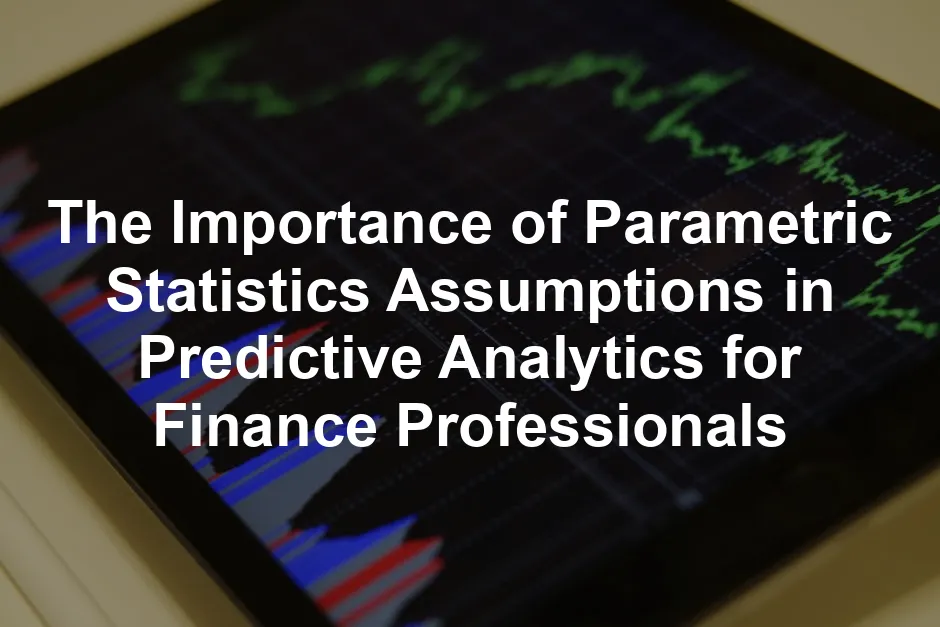Introduction
In the high-stakes world of finance, where every decision can lead to either windfall profits or catastrophic losses, the importance of robust predictive analytics cannot be overstated. Just like a finely-tuned engine, predictive models rely on a set of assumptions to function effectively. However, similar to how a car won’t run on the wrong fuel, predictive models can falter if their underlying assumptions are not met. This article dives deep into the critical role that parametric statistics assumptions play in predictive analytics, specifically tailored for finance professionals. By understanding these assumptions, finance professionals can enhance their decision-making processes and avoid the pitfalls that lead to model failure.
Imagine you’re at a bustling casino, trying to predict whether the roulette wheel will land on red or black. You might have a hunch, but without a solid strategy grounded in reliable data, your chances of winning dwindle. The same goes for financial predictions. Parametric statistics provide the backbone for many predictive models, ensuring that they are built on valid assumptions about data distributions.
Now, let’s talk about some common parametric assumptions: normality, independence, and homoscedasticity. These terms might sound like a foreign language, but they are critical for ensuring your models are as accurate as possible. When these assumptions are violated, it’s like trying to play poker with a deck of cards missing a few suits. The game becomes a lot less predictable, and so do your financial outcomes.
This article will unravel the essential role of these assumptions in the realm of predictive analytics. As finance professionals, understanding these concepts isn’t just useful; it’s imperative. So buckle up, because we’re about to embark on a statistical joyride that will give you the tools to make data-driven decisions with confidence and flair!

Summary Section
The world of predictive analytics in finance is a complex landscape where assumptions are the foundation of reliable models. This article will explore the following key points:
- Understanding Parametric Statistics: We’ll break down the concept of parametric statistics and why they are essential for financial analytics. Parametric methods, grounded in the assumption of a specific data distribution, provide efficient estimates when assumptions hold true.
- The Role of Assumptions in Predictive Models: We will discuss common assumptions made in parametric methods, including normality, independence, and homoscedasticity. Understanding these assumptions is crucial for the development and validation of predictive models.
- Impact of Violating Assumptions: Finance professionals will learn the consequences of ignoring these assumptions and how it can lead to erroneous predictions and financial losses, with examples from past financial crises.
- Best Practices for Model Validation: We will provide actionable insights on how to check for assumption validity, including statistical tests and data visualization techniques that can help ensure that the models are built on solid foundations.
- Decision-Making in Uncertain Environments: Finally, we will discuss strategies for finance professionals to navigate the uncertainty that arises from assumption violations and how to adapt models accordingly.
By exploring these topics, readers will gain a comprehensive understanding of the significance of parametric statistics assumptions in predictive analytics, empowering them to make informed, data-driven decisions in their financial practices.
Understanding Parametric Statistics
Definition and Core Principles
Parametric statistics involve methods that rely on assumptions about the parameters of the population distribution from which samples are drawn. In simpler terms, it’s like making predictions based on a set of rules. These methods assume that the underlying data follows a specific distribution, typically a normal distribution. This is crucial because it allows us to make inferences about a larger population based on a representative sample.
The core principles of parametric statistics include:
- Fixed Parameters: These methods operate under the assumption that certain parameters, like the mean and variance, remain constant. When you know these fixed values, you can create more accurate models.
- Distribution Assumptions: Most parametric tests assume the data follows a normal distribution. If your data is skewed or has outliers, the results may not hold.
- Sample Size: Generally, larger samples yield better estimates of population parameters. The Central Limit Theorem states that as sample size increases, the distribution of the sample mean approaches normality, regardless of the population’s distribution.
Understanding these principles is essential for finance professionals. They help ensure that the conclusions drawn from the data are valid and reliable, laying the groundwork for sound financial decisions.

If you’re looking to deepen your understanding of statistics, consider picking up “Statistics for Business and Economics” by Paul Newbold. This book offers a comprehensive overview of statistical methods tailored for the business world, ensuring you have the tools you need to succeed in finance.
Common Parametric Methods in Finance
Finance professionals often apply several parametric methods to analyze data. Here are a few widely used techniques:
- Regression Analysis: This method examines the relationship between dependent and independent variables. For example, a finance analyst might use regression to predict stock prices based on historical data and various market indicators. If the underlying assumptions are met, regression can yield powerful insights.
- ANOVA (Analysis of Variance): ANOVA is used to compare means among three or more groups. For instance, a company might use ANOVA to assess whether different marketing strategies lead to significantly different sales results. It helps pinpoint effective strategies by comparing the average sales from various campaigns.
- t-Tests: These tests compare the means of two groups to determine if they are statistically different from each other. Imagine a scenario where a bank wants to compare the average loan amounts approved for two different customer demographics. A t-test could provide clarity on potential disparities.
By leveraging these parametric methods, finance professionals can extract valuable insights from their data, enabling them to make informed decisions that drive business success. Each of these methods relies on the fundamental principles of parametric statistics, emphasizing the importance of understanding underlying assumptions.

If you’re curious about the hidden side of economics, you might want to explore “Freakonomics” by Steven D. Levitt. This thought-provoking book explores the quirky undercurrents of economic behavior, revealing insights that could reshape your understanding of finance.
The Role of Assumptions in Predictive Models
Key Assumptions in Parametric Statistics
- Normality: This assumption posits that the data follows a normal distribution. Testing for normality can be done using visual methods like Q-Q plots or statistical tests such as the Shapiro-Wilk test. If data deviates significantly from normality, it could skew results.
- Independence: Observations should be independent of one another. In finance, this means that the outcome of one observation shouldn’t affect another. For example, if analyzing stock returns, one should ensure that each return is not influenced by the previous day’s return.
- Homoscedasticity: This assumption refers to the equality of variances across groups. When conducting regression analysis, it’s essential that the spread of data points around the predicted values remains consistent. Levene’s test can be employed to check for this condition.

Importance of Valid Assumptions
Valid assumptions are the backbone of effective predictive modeling. When assumptions are violated, the results can be misleading and ultimately lead to poor financial decisions. For instance, during the 2008 financial crisis, many financial models failed because they relied on the assumption that housing prices would continue to rise. When prices fell, these models resulted in catastrophic losses for banks and investors alike.
Another example is when a company conducts a t-test to compare the effectiveness of two marketing strategies. If the assumptions of normality and independence are violated, the results could falsely suggest one strategy is superior to the other, leading to misguided marketing investments.
In summary, understanding and adhering to the assumptions of parametric statistics is crucial for finance professionals. It ensures that predictive models are built on solid ground, providing reliable insights that can guide decision-making in complex financial environments. By recognizing the significance of these assumptions, finance practitioners can enhance their analytical capabilities, leading to better outcomes and more strategic choices.

For a deeper dive into the world of financial forecasting, consider reading “The Big Short” by Michael Lewis. This gripping account of the financial crisis illustrates how flawed assumptions can lead to disastrous outcomes.
Impact of Violating Assumptions
Case Studies
In the finance world, assumptions are the unsung heroes of predictive modeling. When they go rogue, chaos often follows. Let’s take a stroll down memory lane to examine a few financial crises that illustrate this point.
Take the 2008 financial crisis, for instance. Financial institutions based their predictions on models that assumed housing prices would keep soaring. Who could blame them? Home values had been on an upward trend for years. But when the housing bubble burst, these models crumbled. Suddenly, the assumption that housing prices were stable became a catastrophic miscalculation. Banks and investors faced monumental losses, and the economy spiraled into recession. A classic case of “assumption-itis,” if you will.
Another example is the dot-com bubble in the late 1990s. Analysts used models that relied heavily on the assumption that internet-based companies would generate massive profits. Many ignored the fact that these companies often operated at a loss. When reality hit, stock prices plummeted, and investors were left holding the bag. The consequences of ignoring fundamental assumptions cost many their livelihoods.
These case studies highlight a crucial lesson: assumptions matter. Ignoring them can lead to dire consequences. As finance professionals, it’s essential to question the validity of the assumptions underlying your predictive models.

Consequences of Misguided Decisions
Now, let’s talk about the aftermath of ignoring assumptions. The consequences can be dire, leading to misguided decisions and financial losses that could make even the most seasoned professional cringe.
Imagine making investment decisions based on flawed predictions. If your model assumes that economic conditions are stable but fails to account for volatility, you may find yourself in a precarious position. The importance of rigorous validation processes cannot be overstated. Validating your assumptions ensures that your models are grounded in reality, not wishful thinking.
Improper assumptions can lead to financial miscalculations. For instance, a company may forecast revenue growth based on models that assume market conditions are favorable. However, if a recession hits unexpectedly, those forecasts become worthless. The company could face severe cash flow issues, leaving it scrambling to stay afloat.
Moreover, the ripple effects of misguided decisions extend beyond a single organization. The wider economy can feel the impact, as businesses cut costs, lay off employees, and reduce investments. This creates a vicious cycle that can lead to further financial instability.
In conclusion, finance professionals must rigorously validate their models. Ignoring the assumptions can result in severe financial miscalculations and losses. It’s essential to approach predictive analytics with a healthy skepticism and a commitment to ongoing assessment.

Best Practices for Model Validation
Techniques to Validate Assumptions
So, how do we keep our models in check? Let’s talk about some tried-and-true techniques for validating assumptions. First up is the Shapiro-Wilk test for normality. This statistical test checks if your data follows a normal distribution. If it doesn’t, it’s time to rethink your approach.
Another handy tool is the Q-Q plot. This visual method allows you to compare your data distribution against a theoretical normal distribution. If your data points fall along the diagonal line, you’re in good shape. If they deviate significantly, it’s a sign that your data may not meet the normality assumption.
Residual plots are also essential in assessing the homoscedasticity assumption. These plots help you visualize the spread of residuals (the differences between observed and predicted values). If the spread remains constant across all levels of your independent variable, you’re golden. If the spread varies, it’s time to investigate further.
By employing these techniques, finance professionals can catch potential issues before they become full-blown disasters. Validation is not just a checkbox; it’s a critical step in ensuring your models are reliable.
Continuous Monitoring and Adjustment
The world of finance is ever-changing, and so are the assumptions that underpin predictive analytics. Continuous monitoring and adjustment are vital to keeping your models relevant.
Ongoing assessment of model assumptions helps you stay ahead of potential pitfalls. Regularly revisiting your assumptions ensures that they still align with current market conditions and empirical data. It’s like giving your model a regular check-up—because nobody wants to be caught off-guard.
Adaptive strategies can also enhance the robustness of your financial models. Consider incorporating scenario analysis to account for various potential outcomes. This approach allows you to gauge how different assumptions might impact your predictions.
In a nutshell, finance professionals must embrace continuous monitoring and adjustment. By doing so, they can adapt their predictive models to changing conditions, ensuring they remain a valuable tool in the decision-making process. After all, in the world of finance, staying flexible is key to success.

Decision-Making in Uncertain Environments
Strategies for Navigating Uncertainty
Uncertainty in finance is as common as coffee breaks in the office. To thrive, finance professionals must embrace flexibility in their models. Flexibility allows these models to adapt, accommodating unexpected market shifts. Here are some strategies to consider:
- Incorporating Flexibility: Introduce dynamic parameters in your financial models. By allowing certain variables to change over time, you can better respond to market fluctuations. Think of it as a financial yoga practice; the more you stretch, the more adaptable you become.
- Sensitivity Analysis: This technique assesses how sensitive your model outcomes are to changes in input values. By tweaking your assumptions—such as growth rates or interest rates—you can identify which variables most impact your model’s predictions. This helps prioritize focus areas and prepare for potential surprises.
- Scenario Planning: Create different financial scenarios based on varying assumptions. This could include best-case, worst-case, and most-likely scenarios. By envisioning multiple futures, you can better prepare for whatever comes your way. It’s like packing for a trip; you might not need that parka, but it’s better to have it just in case.
- Stress Testing: Similar to a workout for your models, stress testing evaluates how they perform under extreme conditions. By pushing your models to their limits, you can identify weaknesses and adjust accordingly. This proactive approach can save you from disastrous financial pitfalls later.
- Continuous Learning: The financial landscape is ever-changing. Stay updated with market trends and adjust your models accordingly. Regularly revisiting your assumptions will keep your models relevant and resilient. After all, learning is a lifelong journey, not a destination.
By incorporating these strategies, finance professionals can navigate uncertainty with confidence. Flexibility and foresight will allow for better decision-making and improved financial outcomes.

If you’re interested in gaining insights from behavioral economics, check out “Thinking, Fast and Slow” by Daniel Kahneman. This book delves into the dual systems of thought that influence our decisions, a must-read for any finance professional.
The Role of Non-Parametric Methods
Non-parametric methods are the unsung heroes of statistical analysis. When parametric assumptions are violated, non-parametric methods step in to save the day. They don’t rely on strict assumptions about data distribution, making them a more flexible alternative.
- Advantages of Non-Parametric Methods: Fewer Assumptions: They don’t require the data to fit a specific distribution. This is great news for those dealing with real-world data, which often strays from the ideal.
- Robust to Outliers: Non-parametric tests are less affected by outliers. This means you can trust your results even when your data misbehaves. Imagine throwing a party with a few rowdy guests; you can still enjoy the gathering, as long as everyone else behaves.
- Limitations of Non-Parametric Methods: Less Powerful: While they’re flexible, non-parametric methods often have less statistical power compared to parametric tests when the latter’s assumptions are satisfied. This means they may be less likely to detect true effects.
- Complex Interpretations: The results from non-parametric tests can sometimes be harder to interpret. Think of it as deciphering a mystery novel; it might take longer to unravel the plot, but the journey can be just as rewarding.
In finance, non-parametric methods can be particularly useful when dealing with skewed data or ordinal variables. Techniques like the Wilcoxon rank-sum test or Kruskal-Wallis test can provide valuable insights when traditional parametric methods fall short. Embracing these alternatives equips finance professionals with a broader toolbox for tackling data challenges.
FAQs
What are parametric statistics?
Parametric statistics are methods that rely on specific data distribution assumptions. Typically, these methods assume a normal distribution of the data. This assumption allows for more efficient estimation and hypothesis testing. In finance, using parametric statistics can enhance the accuracy of predictive models, making them a popular choice among analysts.
Why are assumptions important in predictive analytics?
Assumptions form the bedrock for the validity of predictive models. If these assumptions are flawed or violated, the results may lead to misleading conclusions. For finance professionals, this can result in poor decision-making, which can be costly. Valid assumptions ensure that models reflect reality, allowing for sound financial strategies.
What happens if I violate these assumptions?
Violating statistical assumptions can lead to inaccurate models. This inaccuracy can result in significant financial losses and misguided strategies. For instance, if a model assumes normality but the data is skewed, predictions may not reflect true market conditions. This misalignment can have dire consequences in the volatile world of finance.
How can I check if my assumptions are met?
There are several ways to validate assumptions. Statistical tests such as the Shapiro-Wilk test can check for normality, while Levene’s test assesses the homogeneity of variances. Additionally, visual methods like Q-Q plots provide insight into whether data meets the required assumptions. Regularly employing these methods can enhance model reliability.
What should I do if my assumptions are violated?
If assumptions are violated, consider transforming your data to better fit the model requirements. Non-parametric methods can also be employed as alternatives, as they do not rely on strict assumptions. Revising your model to align with the actual data characteristics can improve predictive accuracy and provide more reliable insights.
Please let us know what you think about our content by leaving a comment down below!
Thank you for reading till here 🙂
To gain a deeper understanding of statistical learning and its implications, check out an introduction to statistical learning with python book length.
For a comprehensive guide on the various statistical tests available, refer to the flow chart for statistical tests.
All images from Pexels




